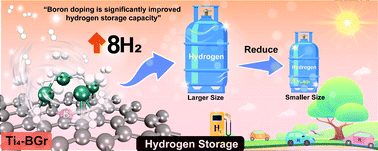Ti4-Decorated B/N-doped graphene as a high-capacity hydrogen storage material: a DFT study†
Abstract
The adsorption properties of the hydrogen atom on our newly designed materials were investigated using density functional theory (DFT) calculations, focusing on the role of dopants in modulating the binding properties of the metal. We proposed decorating Ti4 on pristine, B- and N-doped graphene surfaces for preparing a large-capacity hydrogen-storage device. Computational results indicate that the doping of B on graphene enhances the interaction between the metal cluster and the supporting substrate with a very strong binding energy of −6.45 eV, which is the strongest interaction among our proposed catalysts. This binding energy prevents the aggregation and formation of Ti–metal clusters. Dissociative chemisorption of the first H2 molecule occurs on all materials. Metal hydrides preferentially exhibit strong hybridization between the H-1s and Ti-3d orbitals. Furthermore, Ti4 decorated B-graphene is the most effective, with a high capacity of hydrogen adsorption which could be released under practical conditions. We confirmed that eight H2 molecules could stably adsorb on Ti4/BGr with six reversible hydrogen adsorptions. Our proposed B-doped graphene-based material, Ti4/BGr, offers high cluster-stability on the substrate with high-capacity hydrogen storage compared to various other surfaces in the previous work. Therefore, Ti4 decorated B-graphene is a promising candidate material for use as a reversible hydrogen storage material.



 Please wait while we load your content...
Please wait while we load your content...